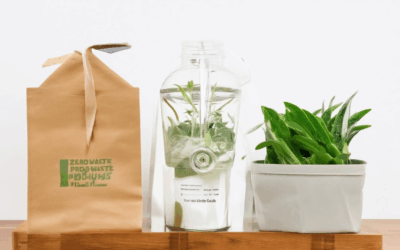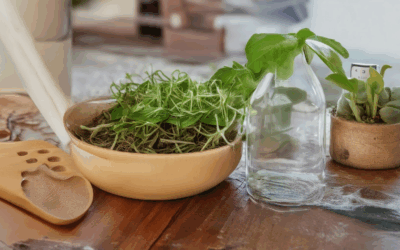Creating a zero-waste cleaning routine that aligns with your unique lifestyle can seem daunting, especially when there are countless options and strategies to consider. However, with the right approach, you can craft a sustainable cleaning routine that not only minimizes waste but also fits seamlessly into your daily life. Whether you’re a busy professional, a pet owner, or someone looking to reduce their carbon footprint, this guide offers practical tips and insights to help you design a zero-waste cleaning routine that works for you. From essential tools and products to customizable schedules and checklists, we’ll explore how to streamline your cleaning process while keeping your home fresh and clutter-free. By adopting a structured and personalized routine, you can enjoy a cleaner space without compromising on convenience or effectiveness. Let’s dive into how you can create a zero-waste cleaning routine that truly suits your lifestyle.
Zero-Waste Cleaning Routine: A Personalized Approach
Adopting a zero-waste cleaning routine can significantly reduce your environmental impact while maintaining a healthy and efficient home. Here’s a structured plan tailored to your lifestyle:
Eco-Friendly Products
- Reusable Cleaning Tools: Opt for microfiber cloths and old cotton shirts as substitutes for disposable items. These are durable, washable, and perfect for dusting, mopping, and wiping.
- Multi-Purpose Cleaners: Use a single, effective cleaner for various surfaces to minimize product variety and packaging waste.
- Homemade Solutions: Create your own cleaning agents using vinegar, baking soda, and essential oils to avoid harmful chemicals and plastic bottles.
Refillable Containers
- Invest in large, refillable containers for cleaning supplies like laundry detergent and dish soap. Check local stores or online platforms for bulk options to reduce plastic waste.
Waste Management
- Separate Trash: Designate containers for recyclables, compostables, and general waste. Use a small bin near the sink for kitchen scraps to compost or donate.
- Responsible Disposal: Research local guidelines for disposing of old cleaning products, ensuring they are recycled or disposed of safely.
Sustainable Brands
- Support eco-friendly brands such as Eco Planeta Verde, which offers sustainable products packaged responsibly.
Organizational Tips
- Maintain a tidy cleaning area to prevent clutter and waste accumulation. Efficient organization can enhance cleaning routines and reduce waste.
Lifestyle Considerations
- Routine Management: Schedule weekly cleaning sessions focused on high-traffic areas like the kitchen and bathroom. Test new solutions on small surfaces first.
- Water Conservation: Use a bucket for mopping and install low-flow fixtures to conserve water and energy.
- Air Quality: Incorporate air-purifying plants to improve indoor air quality, counteracting any chemical residues from cleaning.
Household Involvement
- Engage family members in cleaning tasks, assigning responsibilities to distribute the workload and foster eco-friendly habits.
Progress Tracking
- Keep a cleaning log to monitor the effectiveness of your routine. Note successes and areas for improvement to refine your strategy continuously.
By integrating these strategies, you can create a sustainable, efficient, and personalized zero-waste cleaning routine that aligns with your lifestyle and contributes positively to the environment.

Creating a Zero-Waste Cleaning Routine for Your Lifestyle
To establish a sustainable cleaning routine, consider the following organized approach:
1. Choose Eco-Friendly Products
Select natural cleaning agents such as vinegar, baking soda, castile soap, and essential oils. These options minimize chemical exposure and reduce plastic waste. Explore local stores or online platforms like Eco Planet Verde for affordable and effective products.
2. Optimize Cleaning Tools
Invest in reusable tools like microfiber cloths, bamboo sponges, and washable rags. These replace disposable items and reduce waste. Consider using a bucket for rinsing to conserve water and a reusable spray bottle for diluting cleaning solutions.
3. Develop a Customized Schedule
Tailor your cleaning routine to suit your lifestyle. Implement daily spot cleaning, weekly deep cleans, and monthly maintenance. Adjust frequencies based on your household size and activity level to maintain effectiveness without excess effort.
4. Manage Waste Effectively
Separate recyclables and compost kitchen scraps properly. Use biodegradable bags for trash and invest in a compost bin to reduce landfill waste. Visit Eco Planet Verde’s Composting Guide for setup tips.
5. Evaluate Surface Types
Research suitable eco-friendly cleaners for different surfaces. Use gentle methods for delicate surfaces like glass and safe, non-abrasive solutions for carpets and upholstery to prevent damage.
6. Monitor and Adjust
Keep a cleaning log to track product effectiveness and waste reduction. Regularly review and update your routine to enhance efficiency and sustainability.
By integrating these strategies, you can create a personalized zero-waste cleaning routine that aligns with your lifestyle, promoting environmental stewardship and efficiency.
Creating a Zero-Waste Cleaning Routine for Your Lifestyle
To establish a sustainable cleaning routine, consider the following organized approach:
1. Choose Eco-Friendly Products
Select natural cleaning agents such as vinegar, baking soda, castile soap, and essential oils. These options minimize chemical exposure and reduce plastic waste. Explore local stores or online platforms like Eco Planet Verde for affordable and effective products.
2. Optimize Cleaning Tools
Invest in reusable tools like microfiber cloths, bamboo sponges, and washable rags. These replace disposable items and reduce waste. Consider using a bucket for rinsing to conserve water and a reusable spray bottle for diluting cleaning solutions.
3. Develop a Customized Schedule
Tailor your cleaning routine to suit your lifestyle. Implement daily spot cleaning, weekly deep cleans, and monthly maintenance. Adjust frequencies based on your household size and activity level to maintain effectiveness without excess effort.
4. Manage Waste Effectively
Separate recyclables and compost kitchen scraps properly. Use biodegradable bags for trash and invest in a compost bin to reduce landfill waste. Visit Eco Planet Verde’s Composting Guide for setup tips.
5. Evaluate Surface Types
Research suitable eco-friendly cleaners for different surfaces. Use gentle methods for delicate surfaces like glass and safe, non-abrasive solutions for carpets and upholstery to prevent damage.
6. Monitor and Adjust
Keep a cleaning log to track product effectiveness and waste reduction. Regularly review and update your routine to enhance efficiency and sustainability.
By integrating these strategies, you can create a personalized zero-waste cleaning routine that aligns with your lifestyle, promoting environmental stewardship and efficiency.

Creating a Zero-Waste Cleaning Routine
To establish a sustainable zero-waste cleaning routine, begin by evaluating your current habits and selecting eco-friendly products that align with your lifestyle. Here’s a structured approach:
1. Assess Current Habits and Space
- Identify areas where waste occurs most frequently, such as kitchen messes or bathroom cleaning.
- Evaluate storage space for new containers and cleaning tools.
2. Choose Eco-Friendly Products
- Microfiber Cloths: Replace paper towels with reusable microfiber cloths for dusting and mopping. They are highly absorbent and durable, reducing the need for single-use items.
- Vinegar and Baking Soda: Use these as multi-purpose cleaners. Vinegar cuts through grease, while baking soda tackles stains and odors. Combine them for a powerful cleaning solution.
- Refillable Containers: Invest in reusable containers for cleaning supplies. Look for options online or at local stores to minimize plastic waste.
- Bulk Purchasing: Buy cleaning products in bulk to reduce packaging waste. Consider storage solutions that fit your space efficiently.
3. Opt for Durable and Reusable Items
- Select washable sponges or brushes over disposable ones to reduce waste.
- Look for biodegradable scrubbers or natural fiber brushes for sustainable cleaning tools.
4. Implement Composting
- Start composting kitchen scraps in a simple container. Acceptable foods include fruits, vegetables, and coffee grounds. Avoid meats and dairy for safety.
- Consider joining local composting groups or using municipal programs to manage waste effectively.
5. Develop an Efficient Cleaning Schedule
- Focus on less frequent, thorough cleaning sessions rather than constant cleaning to reduce resource use.
- Use time-saving techniques and smart devices to streamline your routine, such as automated vacuums or robotic mops.
6. Explore DIY Cleaning Solutions
- Experiment with homemade cleaning mixes using ingredients like hydrogen peroxide for disinfecting and essential oils for fragrance.
- Test these solutions on small surfaces to ensure effectiveness before full-scale use.
7. Stay Informed and Involved
- Research local recycling centers to correctly dispose of cleaning product packaging.
- Engage with online communities or local groups focused on sustainability to gain tips and support.
By systematically addressing each aspect of your routine, you can create a personalized zero-waste strategy that fits your lifestyle while promoting environmental responsibility.

Best Strategies for Maintaining a Zero-Waste Cleaning Routine
- Use Reusable Cleaning Tools: Opt for washable and reusable items like microfiber cloths, sponge pads, and scrubbers instead of disposable ones. These can be cleaned and reused multiple times, reducing waste.
- Adopt Multi-Purpose Products: Choose cleaning agents that work for multiple surfaces or tasks. For example, a multipurpose cleaner can handle both bathroom and kitchen messes, minimizing the need for multiple products.
- Refill Cleaning Supplies: Buy large refillable containers for items like laundry detergent, dish soap, and cleaning sprays. Many stores now offer bulk options or refills, reducing plastic waste.
- Create DIY Cleaning Solutions: Make your own cleaning products using simple ingredients like white vinegar, baking soda, and essential oils. This cuts down on plastic packaging and chemical waste.
- Practice Proper Waste Separation: Keep a small container for household scraps and food waste near the sink. Proper segregation ensures that organic waste can be composted or donated to local programs.
- Recycle Responsibly: Check local regulations before disposing of old cleaning products. Many can be recycled, but others may require special disposal methods to prevent harm to the environment.
- Support Eco-Friendly Brands: Invest in companies that prioritize sustainability. Look for products packaged in biodegradable materials or made from renewable resources. Eco Planeta Verde offers a variety of such options on their website.
- Minimize Clutter: Keep your cleaning area organized to reduce the likelihood of waste accumulation. A tidy space often leads to more efficient cleaning routines and less waste generation.
Eco Planeta Verde provides comprehensive guides on sustainable living practices, including detailed tips on creating a zero-waste cleaning routine. Explore their resources for more actionable advice and inspiration to reduce your environmental footprint.
Creating a Zero-Waste Cleaning Routine
Building a zero-waste cleaning routine requires thoughtful planning and sustainable habits. Here’s a step-by-step guide to crafting an effective and eco-friendly cleaning routine:
- 1. Choose Sustainable Products
- Opt for biodegradable and plant-based cleaning agents.
- Select microfiber cloths over paper towels for dusting and mopping.
- Invest in reusable cleaning tools like bamboo sponges or old cotton shirts.
- Use bulk refill stations for household essentials like vinegar and baking soda.
- 2. Minimize Single-Use Plastics
- Avoid plastic bottles and packaging by storing liquids in glass containers.
- Use cloth bags for food scrap collection instead of plastic wrap.
- Choose cardboard or paper packaging for cleaning products whenever possible.
- 3. Implement a Refill System
- Shop in bulk for cleaning supplies to reduce packaging waste.
- Consider local businesses or online stores that offer refill options.
- Keep a reusable container handy for storing homemade cleaning solutions.
- 4. Practice Proper Waste Segregation
- Separate recyclable materials, compostable scraps, and general waste.
- Use a compost bin for organic waste like fruit peels and coffee grounds.
- Recycle old cleaning products properly or donate them to those in need.
- 5. Conserve Water and Energy
- Use a bucket for mopping instead of running water.
- Install low-flow fixtures in your bathroom and kitchen.
- Air dry clothes instead of using a dryer to save energy and water.
- 6. Schedule Regular Cleanings
- Clean frequently to prevent buildup and reduce the need for harsh chemicals.
- Plan your cleaning schedule around your lifestyle to maintain consistency.
- Rotate responsibilities if possible to spread the workload and reduce waste.
- 7. Educate Yourself and Others
- Learn about the lifecycle of cleaning products to make informed choices.
- Share tips and tricks with friends and family to encourage eco-friendly habits.
- Stay updated on new sustainable products and innovations.

Creating a Zero-Waste Cleaning Routine
To establish a sustainable cleaning routine, begin by selecting eco-friendly products such as vinegar, baking soda, castile soap, and essential oils. These alternatives effectively clean various surfaces without harmful chemicals, reducing your environmental footprint.
Minimize Waste
Refillable containers are ideal for storing cleaning supplies, minimizing plastic waste. Consider composting kitchen scraps in a designated bin to reduce landfill contributions. Separate recyclables and compostables properly to maximize resource efficiency.
Sustainable Tools
Invest in microfiber cloths and reusable rags to absorb dirt efficiently. Opt for eco-friendly sponges or scrubbers made from natural fibers. These tools reduce reliance on disposable items and maintain cleaning effectiveness.
Tailoring Your Routine
Adjust your cleaning frequency according to your lifestyle. High-traffic areas may require weekly attention, while less frequently used spaces can be cleaned monthly. Test cleaning solutions on small areas first to ensure effectiveness and safety for your surfaces.
Air Quality Considerations
Consider incorporating air-purifying plants or using an air purifier to mitigate chemical residues. This enhances indoor air quality, making your space healthier and more pleasant.
Involving Households
Engage family members in the cleaning process by assigning responsibilities. Use labeled bins for individual recyclables and compostables to streamline the process and encourage participation.
Progress Tracking
Keep a cleaning log to monitor your routine’s effectiveness. Note which products perform best and adjust accordingly. This approach helps refine your strategy over time and ensures ongoing improvements.
By thoughtfully integrating these strategies, you can create a personalized zero-waste cleaning routine that aligns with your lifestyle and contributes positively to the environment.




0 Comments